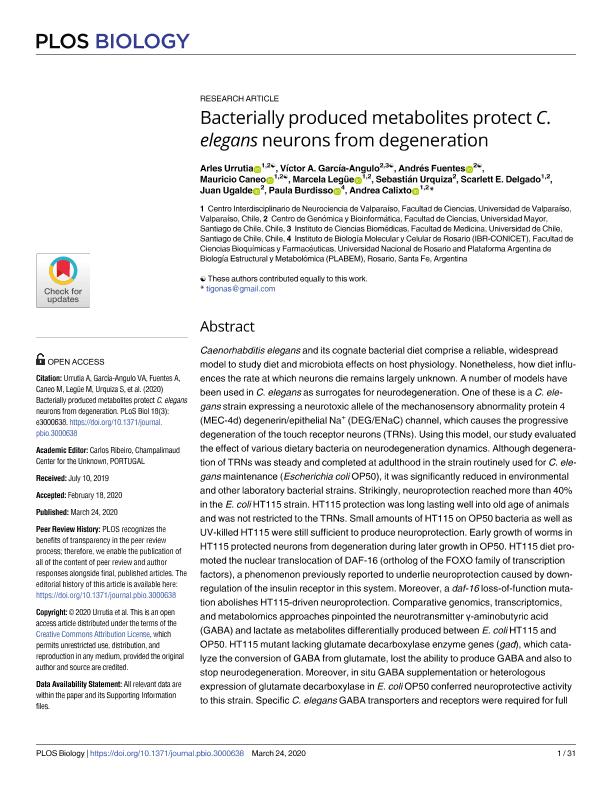Artículo
Bacterially produced metabolites protect C. elegans neurons from degeneration
Urrutia, Arles; García Angulo, Víctor Antonio; Fuentes, Andrés; Caneo, Mauricio; Legüe, Marcela; Urquiza, Sebastián; Delgado, Scarlett E.; Ugalde, Juan Esteban ; Burdisso, Paula
; Burdisso, Paula ; Calixto, Andrea
; Calixto, Andrea
 ; Burdisso, Paula
; Burdisso, Paula ; Calixto, Andrea
; Calixto, Andrea
Fecha de publicación:
03/2020
Editorial:
Public Library of Science
Revista:
PLoS Biology
e-ISSN:
1545-7885
Idioma:
Inglés
Tipo de recurso:
Artículo publicado
Clasificación temática:
Resumen
Caenorhabditis elegans and its cognate bacterial diet comprise a reliable, widespread model to study diet and microbiota effects on host physiology. Nonetheless, how diet influences the rate at which neurons die remains largely unknown. A number of models have been used in C. elegans as surrogates for neurodegeneration. One of these is a C. elegans strain expressing a neurotoxic allele of the mechanosensory abnormality protein 4 (MEC-4d) degenerin/epithelial Na+ (DEG/ENaC) channel, which causes the progressive degeneration of the touch receptor neurons (TRNs). Using this model, our study evaluated the effect of various dietary bacteria on neurodegeneration dynamics. Although degeneration of TRNs was steady and completed at adulthood in the strain routinely used for C. elegans maintenance (Escherichia coli OP50), it was significantly reduced in environmental and other laboratory bacterial strains. Strikingly, neuroprotection reached more than 40% in the E. coli HT115 strain. HT115 protection was long lasting well into old age of animals and was not restricted to the TRNs. Small amounts of HT115 on OP50 bacteria as well as UV-killed HT115 were still sufficient to produce neuroprotection. Early growth of worms in HT115 protected neurons from degeneration during later growth in OP50. HT115 diet promoted the nuclear translocation of DAF-16 (ortholog of the FOXO family of transcription factors), a phenomenon previously reported to underlie neuroprotection caused by downregulation of the insulin receptor in this system. Moreover, a daf-16 loss-of-function mutation abolishes HT115-driven neuroprotection. Comparative genomics, transcriptomics, and metabolomics approaches pinpointed the neurotransmitter γ-aminobutyric acid (GABA) and lactate as metabolites differentially produced between E. coli HT115 and OP50. HT115 mutant lacking glutamate decarboxylase enzyme genes (gad), which catalyze the conversion of GABA from glutamate, lost the ability to produce GABA and also to stop neurodegeneration. Moreover, in situ GABA supplementation or heterologous expression of glutamate decarboxylase in E. coli OP50 conferred neuroprotective activity to this strain. Specific C. elegans GABA transporters and receptors were required for full HT115-mediated neuroprotection. Additionally, lactate supplementation also increased anterior ventral microtubule (AVM) neuron survival in OP50. Together, these results demonstrate that bacterially produced GABA and other metabolites exert an effect of neuroprotection in the host, highlighting the role of neuroactive compounds of the diet in nervous system homeostasis.
Palabras clave:
C. ELEGANS
,
DIET
,
MICROBIOTA
,
NEUROPROTECTION
Archivos asociados
Licencia
Identificadores
Colecciones
Articulos(IBR)
Articulos de INST.DE BIOLOGIA MOLECULAR Y CELULAR DE ROSARIO
Articulos de INST.DE BIOLOGIA MOLECULAR Y CELULAR DE ROSARIO
Citación
Urrutia, Arles; García Angulo, Víctor Antonio; Fuentes, Andrés; Caneo, Mauricio; Legüe, Marcela; et al.; Bacterially produced metabolites protect C. elegans neurons from degeneration; Public Library of Science; PLoS Biology; 18; 3; 3-2020; 1-31
Compartir
Altmétricas



